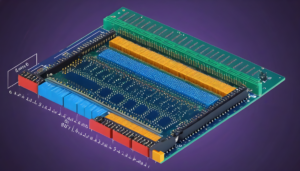Real-time processing is becoming more and more necessary in the technology-driven environment of today, which includes the aerospace, defense, industrial automation, and communication systems sectors.
Due to this demand, Real-Time Operating Systems (RTOS), which deal with strict timing requirements, have become crucial. Field-Programmable Gate Arrays (FPGAs) are an alluring alternative for implementing real-time systems because they provide unmatched flexibility and parallel processing capacity.
RTOS, which is designed to perform operations with deterministic timing, contrasts with traditional operating systems, which frequently display variable execution timings. For applications like medical devices, vehicle safety systems, and industrial controls, where missed deadlines might have serious repercussions, this predictability is essential. FPGAs, on the other hand, are hardware platforms that can be dynamically reconfigured.
FPGAs permit post-manufacturing programming, in contrast to Application-Specific Integrated Circuits (ASICs), providing versatile and adaptable designs. FPGAs are excellent at carrying out specialized tasks since they are made up of programmable logic blocks that are coupled for parallel processing.
A powerful solution for real-time applications arises by combining RTOS and FPGAs. The deterministic multitasking capabilities of RTOS are combined with the parallel processing power of the FPGA to deliver high-throughput, low-latency execution. Applications requiring both real-time responsiveness and complex data processing can benefit from this combination.
The advantages, implementation quirks, and case studies of combining Real-Time Operating Systems and Field-Programmable Gate Arrays will all be covered in this investigation. Engineers may make well-informed judgments and deploy real-time, high-performance systems across a variety of domains by gaining knowledge of this integration.
Benefits of Using RTOS on FPGAs
Field-Programmable Gate Arrays (FPGAs) and Real-Time Operating Systems (RTOS) work together to provide a number of important advantages. This pairing can enable improved performance, determinism, and scalability, making it an attractive option for a variety of applications that demand real-time responsiveness and effective resource usage. The following are some major advantages of RTOS usage on FPGAs:
A. Determinism and Real-Time Responsiveness:
Predictable Task Execution: A framework for planning and carrying out tasks with set priorities and deadlines is provided by RTOS. The hardware resources may be precisely assigned and managed when implemented on an FPGA, resulting in predictable and guaranteed task execution times.
Critical Applications: Real-time responsiveness is crucial to sectors including aircraft, automotive, and industrial automation. Stringent timing specifications can be met by FPGAs running RTOS, guaranteeing that safety-critical activities are reliably carried out within set time constraints.
B. Multitasking and Task Scheduling:
Concurrent Execution: RTOS allows for efficient multitasking by dividing the application into smaller tasks or threads. On FPGAs, these tasks can be executed in parallel, leveraging the inherent parallel processing capabilities of FPGA architectures.
Resource Optimization: FPGAs enable dedicated hardware accelerators to be integrated into the RTOS, offloading computation-intensive tasks from the processor cores. This parallelism enhances overall system throughput and reduces the burden on the CPU.
C. Resource Management and Optimization:
Efficient Memory Utilization: FPGAs can be configured to utilize on-chip memory resources efficiently. RTOS helps manage memory allocation and deallocation, ensuring optimal usage and minimizing memory fragmentation.
Hardware-Accelerated Operations: RTOS can take advantage of FPGA’s ability to implement custom hardware accelerators tailored to specific tasks. This approach significantly improves performance for tasks like signal processing, cryptography, and data manipulation.
Considerations for Choosing an RTOS on FPGAs
There are a number of important factors to take into account when choosing a Real-Time Operating System (RTOS) for Field-Programmable Gate Arrays (FPGAs). The real-time performance, determinism, and overall effectiveness of the embedded system can be considerably impacted by the RTOS selection and its integration with FPGA hardware. The following are crucial elements to think about before making this choice:
A. RTOS Selection Criteria:
Real-Time Capabilities: Utilizing an RTOS is mostly done to satisfy real-time requirements. Make that the RTOS has demonstrated real-time capabilities, such as quick context switching, predictable task scheduling, and low interrupt latency.
Scalability and Footprint: The RTOS needs to be scalable enough to handle the application’s complexity while still having a manageable memory and processing overhead. As FPGAs frequently have constrained on-chip memory resources, take into account the RTOS kernel’s memory footprint.
Compatibility with FPGA Platforms: Make sure the RTOS is appropriate for the particular FPGA platform you’re utilizing. For some FPGA families or development tools, some RTOS alternatives might be more appropriate.
B. Integration with FPGA Hardware:
Interface with FPGA Peripherals and Custom IP: FPGAs often incorporate custom IP cores and specialized hardware interfaces. The RTOS should have provisions for integrating with these hardware components seamlessly.
Low-Level Driver Development: Depending on the RTOS, you may need to develop low-level drivers to interface with FPGA-specific peripherals and custom hardware blocks. This requires a good understanding of both the RTOS and FPGA hardware architecture.
C. Real-Time Application Requirements:
Hard vs. Soft Real-Time Constraints: Recognize the nature of the real-time needs of your application. Some applications have strict real-time deadline requirements, making missing a deadline extremely important and perhaps disastrous. Others may operate under “soft real-time constraints,” which allow for the occasional missed deadline.
Impact of Interrupt Latency: The RTOS’s interrupt latency might affect how responsive the system is. Applications like control systems that require quick responses must minimize interrupt latency.
Implementation of RTOS on FPGAs
Real-Time Operating System (RTOS) implementation on Field-Programmable Gate Arrays (FPGAs) poses particular difficulties and opportunities. The practical features of integrating an RTOS with an FPGA platform are covered in this section, including how to modify the RTOS for FPGA design, incorporate the RTOS kernel, and implement efficient task management and scheduling techniques.
A. RTOS Adaptation for FPGA Architecture
Memory Hierarchy Considerations: On-chip memory blocks, distributed memory, and external memory interfaces are just a few of the many memory topologies available in FPGAs. It is essential to modify the RTOS to effectively utilize these memory resources. For maximum performance, the memory hierarchy of the FPGA must be coordinated with the memory allocation and management techniques of the RTOS.
Handling Asynchronous Events: FPGAs can manage numerous processes at once because they are naturally parallel. However, managing asynchronous events like interruptions calls for careful thought. In order to provide real-time responsiveness without affecting other processes, the RTOS should be able to effectively manage and prioritize interrupts.
B. Integration of RTOS Kernel
Porting the RTOS to FPGA: An RTOS’s codebase must be modified to fit the hardware description language (HDL) environment of an FPGA in order to be ported to that device. This stage frequently calls for proficiency in both FPGA programming and software development. The job scheduling algorithms and synchronization primitives of the RTOS must be adjusted to the parallelism of the FPGA.
Hardware Abstraction Layer (HAL) Development: Developing a HAL that abstracts FPGA-specific functionalities is essential for ease of portability across different FPGA platforms. The HAL provides a standardized interface to interact with FPGA peripherals and custom IP cores, shielding the application code from low-level FPGA intricacies.
C. Task Management and Scheduling
Mapping Tasks to FPGA Resources: FPGAs offer a plethora of configurable hardware resources, such as DSP blocks and lookup tables, which can be exploited to accelerate tasks. During implementation, tasks should be mapped to appropriate FPGA resources based on their computational requirements, communication patterns, and timing constraints.
Utilizing Hardware Timers for Scheduling: FPGA platforms usually include hardware timers that can be employed to facilitate precise task scheduling. These timers enable accurate tracking of time intervals and can be utilized by the RTOS to enforce deadlines and manage task execution in a deterministic manner.
Conclusion
Field-Programmable Gate Arrays (FPGAs) and Real-Time Operating Systems (RTOS) working together is an innovative synergy with the potential to revolutionize technology. With applications ranging from avionics to communication networks, this convergence provides predictable real-time responsiveness.
The successful implementation of an RTOS on FPGAs requires a seamless fusion of software and hardware skills. Getting through difficulties like memory hierarchy alignment and asynchronous event management emphasizes how interdisciplinary this project is.
Looking ahead, the future is promising. Future real-time capabilities will be redefined by intelligent, responsive systems thanks to heterogeneous computing architectures, the integration of AI/ML with RTOS, and FPGAs.
In conclusion, the RTOS-FPGA cooperation exemplifies human ingenuity, overcoming constraints to transform the high-performance computing world. This synergy is a monument to our unwavering pursuit of growth as well as a technological advancement.












